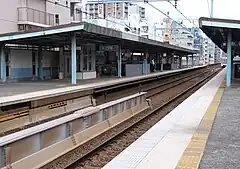Ōmorikaigan Station
Ōmorikaigan Station (大森海岸駅, Ōmori-Kaigan-eki) is a Keikyu station on the Keikyū Main Line between Tachiaigawa Station and Heiwajima Station. The station is on the borders of Shinagawa and Ota wards. Station number is KK07.
KK07 Ōmorikaigan Station 大森海岸駅 | |||||||||||
|---|---|---|---|---|---|---|---|---|---|---|---|
 Ticket gate | |||||||||||
| General information | |||||||||||
| Location | Minami Ōi 3-32-1, Shinagawa, Tokyo (東京都品川区南大井三丁目32-1) Japan | ||||||||||
| Operated by | Keikyu | ||||||||||
| Line(s) | Keikyū Main Line | ||||||||||
| Other information | |||||||||||
| Station code | KK07 | ||||||||||
| History | |||||||||||
| Opened | 1901 | ||||||||||
| Previous names | Yawata (until 1904); Kaigan (until 1933) | ||||||||||
| Passengers | |||||||||||
| 2010 | 13,673 daily | ||||||||||
| Services | |||||||||||
| |||||||||||

Layout
| 1 | KK Keikyū Main Line | for Yokohama and Uraga KK Keikyū Zushi Line for Zushi·Hayama KK Keikyū Kurihama Line for Misakiguchi |
| 2 | KK Keikyū Main Line | for Shinagawa and Sengakuji A Toei Asakusa Line for Shimbashi and Asakusa KS Keisei Main Line for Narita Airport |
The station consists of two platforms on an overhead railway. Elevators to connect platforms and concourse is set in March 2009. The station has name of "Ōmori", which usually indicates a part of the Ōta ward while the location of the stations is Shinagawa ward.
Entry and exit
Average daily entry and exit in 2015 is 14,391.[1]
Entry and exit in recent years are as shown below.
| Year | Daily average Entry and exit |
From |
|---|---|---|
| 1992 | 8,449 | [2] |
| 1993 | 7,710 | [3] |
| 1994 | 7,014 | [4] |
| 1995 | 6,577 | [5] |
| 1996 | 6,356 | [6] |
| 1997 | 6,027 | [7] |
| 1998 | 5,934 | [8] |
| 1999 | 5,762 | [9] |
| 2000 | 5,901 | [10] |
| 2001 | 5,978 | [11] |
| 2002 | 6,079 | [12] |
| 2003 | 6,068 | [13] |
| 2004 | 6,293 | [14] |
| 2005 | 6,545 | [15] |
| 2006 | 6,581 | [16] |
| 2007 | 6,692 | [17] |
| 2008 | 7,134 | [18] |
| 2009 | 6,951 | [19] |
| 2010 | 6,797 | [20] |
| 2011 | 6,516 | [21] |
| 2012 | 6,663 | [22] |
| 2013 | 6,915 | [23] |
| 2014 | 6,959 | [24] |
Nearby the station
- Shinagawa-kumin Park
- Shinagawa Aquarium
- Isuzu hospital
- Minamiōi Library
- Suzugamori execution grounds ruin
- Big Fun Heiwajima
- Boat Race Heiwajima
- Ito-Yokado Omori store
- Keikyu EX Inn
- Disco Corporation headquarters
- Omori Bell Port
- Omori Bell Port Post Office
- Isuzu Motors headquarters
- Nismo Omori Factory
Transport Links
- Keihin-Tōhoku Line Omori station – 10 minutes walk
- Japan National Route 15
- Suzugamori Ramp - Route 1 (Shuto Expressway)
Omori Kaigan Station bus stop
- East bound
- Keikyu Bus
- <Mori 22> Yashio Park Town Loop
- <Mori 30> Museum of Maritime Science via Tokyo Teleport Station three services a day
- <Mori 28> Heiwajima loop
- <""I"" 19> Leisure land Heiwajima, three services a day
- <Mori 34> Ota Stadium via Leisure land Heiwajima
- <Mori 43> Ota Market
- <Mori 32> Jonanjima loop
- <Mori 24> Keihinjima loop
- <Mori 25> Showajima loop
- <Mori 36> Keihijima and Showajima loop
- <Mori 31> Ryutsu Centre loop
- <Mori 26> Morigasaki
- Haneda Keikyu Bus
- <Mori 21> Haneda Airport
- <Mori 23> Haneda Garage
- Keikyu Bus
- West bound
- Keikyu bus
- <"I" 19> Ōimachi Station via Omori station, three services a day
- <Mori 22, Mori 24, Mori 25, Mori 26, Mori 28, Mori 31, Mori 32, Mori 36, Mori 43, and I 30> Omori station
- Haneda Keikyu bus
- <Mori 21 and Mori 23> Omori station
- Keikyu bus
History
On 1 February 1901, the station was opened as Yawata Station (八幡駅) when the Keihin Electric Railway extension line from Kawasaki to Ōmori Teishajōmae (by Ōmori Station) commenced the service. On 8 May 1904, the main line was extended from this station, concurrently renamed as Kaigan Station (海岸駅), to Shinagawa, making the station a junction of the main line and a branchline to Ōmori Teishajōmae. The branchline was active until 8 March 1937.[25]
The current station name Ōmorikaigan is from 1 July 1933. On 1 December 1970, the work to move the station to the elevated line was completed.
Keikyu introduced station numbering to its stations on 21 October 2010; Ōmorikaigan was assigned station number KK07.[26]
References
- 駅別1日平均乗降人員|
- 東京都統計年鑑(平成4年)
- 東京都統計年鑑(平成5年)
- 東京都統計年鑑(平成6年)
- 東京都統計年鑑(平成7年)
- 東京都統計年鑑(平成8年)
- 東京都統計年鑑(平成9年)
- "東京都統計年鑑(平成10年)" (PDF).
- "東京都統計年鑑(平成11年)" (PDF).
- 東京都統計年鑑(平成12年)
- 東京都統計年鑑(平成13年)
- 東京都統計年鑑(平成14年)
- 東京都統計年鑑(平成15年)
- 東京都統計年鑑(平成16年)
- 東京都統計年鑑(平成17年)
- 東京都統計年鑑(平成18年)
- 東京都統計年鑑(平成19年)
- 東京都統計年鑑(平成20年)
- 東京都統計年鑑(平成21年)
- 東京都統計年鑑(平成22年)
- 東京都統計年鑑(平成23年)
- 東京都統計年鑑(平成24年)
- 東京都統計年鑑(平成25年)
- 東京都統計年鑑(平成26年)
- Miyata, Kensei (2015). 京急電鉄 明治・大正・昭和の歴史と沿線. Tokyo: JTB Publishing. p. 249. ISBN 978-4-533-10675-0.
- "京急線全駅にて駅ナンバリングを開始します" [Station numbering will be introduced to all stations on the Keikyu Line]. KEIKYU WEB. 25 June 2010. Archived from the original on 21 February 2014. Retrieved 27 February 2023.